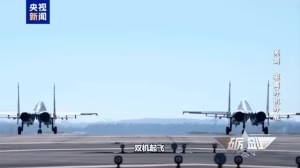US clears Malaysia’s grab of 33 Kuwaiti F/A-18 Hornet jets

The United States has given the green light for Malaysia to acquire up to 33 used F/A-18 Hornet fighter jets from Kuwait, a move that promises to bolster the Royal Malaysian Air Force’s capabilities amid rising tensions in the South China Sea. The approval, confirmed by General Tan Sri Asghar Khan Goriman Khan, chief of the Malaysian Air Force, during a press conference at Kuantan Air Base, marks a significant step in a deal that has been years in the making.

This transaction, governed by the U.S. Arms Export Control Act, required Congressional approval due to the American origin of the aircraft. Malaysia’s pursuit of these jets, a mix of single-seat F/A-18C and two-seat F/A-18D variants, aims to address critical gaps in its air defense while the nation awaits a broader modernization effort projected for the 2040s. The deal underscores Malaysia’s urgency to maintain a credible air presence in a region where territorial disputes and military buildups are reshaping the strategic landscape.
The F/A-18 Hornet, a twin-engine, carrier-capable multirole fighter developed by McDonnell Douglas, has been a cornerstone of tactical aviation since its introduction in the early 1980s. Designed for both air-to-air and air-to-ground missions, the Hornet combines versatility with robust performance. The aircraft’s AN/APG-73 radar, an evolution of the earlier APG-65, provides high-resolution ground mapping and the ability to track multiple targets simultaneously, making it effective for both dogfights and precision strikes.
Powered by two General Electric F404-GE-402 turbofan engines, each producing up to 17,700 pounds of thrust, the Hornet achieves a maximum speed of Mach 1.8 and an operational range of approximately 2,000 kilometers with external fuel tanks. Its payload capacity of 7.7 tons allows it to carry a diverse array of weaponry, including AIM-9X Sidewinder and AIM-120 AMRAAM missiles for air combat, as well as Harpoon anti-ship missiles and Joint Direct Attack Munitions for ground and maritime targets. The aircraft’s mid-air refueling capability extends its endurance, enabling prolonged missions critical for patrolling expansive maritime regions like the South China Sea.
Malaysia’s interest in Kuwait’s Hornets dates back to at least 2017 when the Royal Malaysian Air Force began exploring options to supplement its aging fleet. The Kuwaiti Air Force acquired 40 Hornets—32 F/A-18Cs and eight F/A-18Ds—through the U.S. Foreign Military Sales program in the early 1990s following the Gulf War. These aircraft, maintained with relatively low flight hours, have served in two combat squadrons and a training unit.
Over the years, Kuwait has upgraded its radar, avionics, and electronic warfare systems to keep them combat-relevant. A crash in October 2024 reduced the fleet to 32 airframes, but Malaysian officials, including Defense Minister Datuk Seri Mohamed Khaled Nordin, have described the jets as structurally sound and suitable for their needs.
During a visit to Kuwait’s Ahmad Al-Jaber Air Base in October 2024, Khaled inspected the aircraft and held discussions with Kuwaiti leaders, including Prime Minister Sheikh Ahmad Abdullah Al-Ahmad Al-Sabah, securing Kuwait’s agreement to the sale pending U.S. approval, which was finalized in June 2025, as reported by ZonaJakarta.
The Hornet’s combat pedigree adds to its appeal for Malaysia. During the 1991 Gulf War, U.S. Navy and Marine Corps Hornets flew over 4,500 sorties, downing Iraqi MiG-21s and conducting precision strikes against ground targets. Kuwait’s Hornets, while not as extensively deployed, participated in regional joint exercises with Gulf Cooperation Council nations and U.S. forces, honing tactics for air superiority and maritime strike missions.
These operations provide valuable lessons for Malaysia, particularly for patrolling its exclusive economic zone and countering potential threats in contested waters. The aircraft’s ability to switch roles mid-mission—engaging enemy fighters and then bombing targets—offers the flexibility Malaysia needs to address multifaceted challenges in its airspace and beyond.
Malaysia’s current air force inventory includes eight F/A-18D Hornets, acquired in 1997, alongside 18 Russian-built Sukhoi Su-30MKM fighters. The Hornets, operated by the 18th Squadron at Butterworth Air Base, have received upgrades over the past decade, including the Joint Helmet Mounted Cueing System, Link 16 datalink, and compatibility with advanced munitions like the AIM-9X and Sniper targeting pods. These enhancements improve their air-to-air and air-to-ground capabilities, but the small fleet size limits operational reach.
The Su-30MKMs, while potent, have faced maintenance challenges due to logistical issues, a problem compounded by the retirement of Malaysia’s MiG-29s in 2017 and the aging BAE Hawk 208s. The addition of up to 33 Kuwaiti Hornets could allow Malaysia to expand its Hornet squadron to a standard strength of 12 aircraft and potentially establish a second squadron, significantly boosting its operational capacity.
The acquisition comes as Malaysia navigates a complex regional security environment. The South China Sea, a vital global trade route, has seen escalating tensions due to overlapping territorial claims, particularly involving China’s assertive maritime activities. In May 2021, Malaysia scrambled its Hawk jets in response to 16 Chinese military aircraft approaching within 60 miles of its coast, highlighting the need for a robust air presence.
The Hornets, with their proven anti-ship capabilities, could enhance Malaysia’s ability to monitor and defend its maritime boundaries. Compared to China’s J-15 fighters, which operate from aircraft carriers in the region, the F/A-18C/D lacks stealth but offers comparable multirole flexibility. Against more advanced Chinese platforms like the J-16, the Hornet’s older systems may struggle, but its upgraded avionics and weaponry provide a credible deterrent for now.
Integrating the Kuwaiti Hornets into Malaysia’s air force will not be without challenges. The aircraft, built in the early 1990s, belongs to an earlier production block than Malaysia’s existing F/A-18Ds, potentially complicating maintenance and spare parts compatibility. Malaysia’s experience with its current Hornets, however, gives it a head start in logistics and pilot training. The Air Force has already invested in upgrades to align its Hornets with modern standards, and the Kuwaiti jets may require similar refurbishments to ensure fleet commonality.
The Link 16 datalink, which enables secure data sharing with allied forces, could enhance Malaysia’s interoperability with regional partners like Australia, which also operates F/A-18s. Training programs will need to expand to accommodate additional pilots and ground crews, a process that could strain budgets already stretched by the acquisition of 18 KAI FA-50M light combat aircraft from South Korea in 2023 to replace the retired Hawks.
Kuwait’s decision to sell its Hornets aligns with its own modernization efforts. The Gulf nation is transitioning to 28 F/A-18E/F Super Hornets and 28 Eurofighter Typhoons, with deliveries expected to be completed by 2027. The Super Hornet, a more advanced evolution of the Hornet, features improved radar, greater payload capacity, and enhanced survivability, reflecting the direction of modern tactical aviation. Kuwait’s legacy Hornets, while still capable, are being phased out to make way for these newer platforms.
Malaysia’s acquisition faced competition from Tunisia and even the U.S. Marine Corps, which reportedly considered the Kuwaiti jets for its own needs, as noted by Defence Security Asia. The U.S. approval process, while a formality under the Arms Export Control Act, underscores Washington’s influence over the global trade of its military hardware.
The deal also reflects broader trends in Southeast Asian air forces. Neighbors like Indonesia, which recently acquired French Rafale fighters, and Vietnam, with its Russian Su-35s, are investing in advanced platforms to counter regional uncertainties. Singapore, a regional air power leader, operates F-15s and F-35s, setting a high bar for technological sophistication.
Malaysia’s reliance on legacy Hornets, while cost-effective, raises questions about its ability to keep pace with these developments. The Hornet’s lack of stealth and older radar systems put it at a disadvantage against fifth-generation fighters like China’s J-20 or the U.S. F-35, which are increasingly defining modern air combat. The rise of unmanned systems, such as drones used in recent conflicts, further complicates the future relevance of fourth-generation platforms like the Hornet.
Malaysia’s acquisition strategy is driven by necessity and pragmatism. The nation’s Multi-Role Combat Aircraft program, intended to introduce a new generation of fighters, has been delayed by budget constraints and political indecision, with implementation now projected for the 15th Malaysia Plan around 2040. The Kuwaiti Hornets serve as a stopgap to maintain air combat readiness in the interim.
By leveraging existing infrastructure and expertise with the F/A-18 platform, Malaysia can avoid the delays and costs associated with introducing a new aircraft type. However, operating three distinct platforms—Hornets, Su-30MKMs, and FA-50s—poses logistical challenges. The Su-30MKMs, slated for upgrades to a “Super Flanker” standard, may face hurdles due to contractual issues with Russia, further emphasizing the Hornets’ role as a reliable backbone for the Air Force.
The operational history of the Hornet offers Malaysia a blueprint for its deployment. In U.S. service, the aircraft excelled in conflicts from the Gulf of Sidra in 1986 to Operations Enduring Freedom and Iraqi Freedom, where it performed air superiority, close air support, and suppression of enemy air defenses. Its ability to carry out diverse missions makes it well-suited for Malaysia’s needs, from defending airspace to conducting maritime strikes.
The Kuwaiti Hornets’ experience in joint exercises provides a model for Malaysia to develop tactics for regional cooperation, potentially with nations like Australia or Singapore. The aircraft’s Sniper pod and precision munitions enable accurate strikes against surface targets, a critical capability in the South China Sea, where small, fast vessels could pose threats to maritime security.
The financial aspect of the deal remains a concern. While the Kuwaiti Hornets are a cost-effective alternative to new aircraft, their age—over three decades—means higher maintenance costs and potential obsolescence. Malaysia’s defense budget, strained by competing priorities, may struggle to support the expanded fleet. The FA-50M, a lighter and cheaper platform, offers quick-reaction capabilities but lacks the Hornet’s payload and range.
Balancing these assets will require careful planning to avoid overextending resources. The establishment of a joint Malaysian-Kuwaiti committee to finalize the deal, as reported by Militarnyi, suggests a structured approach to addressing these challenges, including potential training exchanges where Malaysia could provide advanced combat instruction to Kuwaiti pilots.
From a strategic perspective, the acquisition strengthens Malaysia’s position as a neutral but capable player in Southeast Asia. The country’s acceptance as a BRICS partner in 2024, as noted by Yahoo Malaysia News, adds a layer of geopolitical complexity, but the U.S. approval of the deal signals continued alignment with Western military frameworks.
The Hornets’ integration could facilitate joint exercises with U.S. and allied forces, enhancing Malaysia’s role in regional security. However, the deal’s reliance on older technology raises questions about its long-term viability. As fifth-generation fighters and unmanned systems dominate modern warfare, Malaysia’s investment in legacy Hornets may delay the inevitable transition to more advanced platforms.
The approval of this deal marks a pragmatic step for Malaysia to shore up its air defenses in a volatile region. The F/A-18 Hornet, with its proven track record and versatile capabilities, offers a lifeline to an air force grappling with aging assets and delayed modernization plans. Yet the challenges of integrating and maintaining these decades-old jets cannot be overlooked.
As Malaysia navigates the complexities of regional rivalries and technological shifts, the success of this acquisition will hinge on its ability to balance cost, capability, and long-term strategy.
***
Follow us everywhere and at any time. BulgarianMilitary.com has responsive design and you can open the page from any computer, mobile devices or web browsers. For more up-to-date news, follow our Google News, YouTube, Reddit, LinkedIn, and Twitter pages. Our standards: Manifesto & ethical principles.













